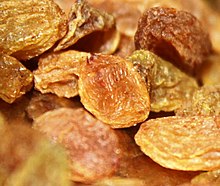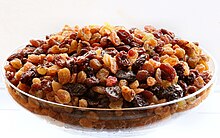This is an old revision of this page, as edited by 150.242.173.245 (talk) at 05:03, 11 November 2020 (Are raisins good for health?). The present address (URL) is a permanent link to this revision, which may differ significantly from the current revision.
Revision as of 05:03, 11 November 2020 by 150.242.173.245 (talk) (Are raisins good for health?)(diff) ← Previous revision | Latest revision (diff) | Newer revision → (diff) Dried grape For other uses, see Raisin (disambiguation).



A raisin is a dried grape. Raisins are produced in many regions of the world and may be eaten raw or used in cooking, baking, and brewing. In the United Kingdom, Ireland, New Zealand, and Australia, the word raisin is reserved for the dark-colored dried large grape, with sultana being a golden-colored dried grape, and currant being a dried small Black Corinth seedless grape.
Etymology
The word "raisin" dates back to Middle English and is a loanword from Old French; in modern French, raisin means "grape", while a dried grape is a raisin sec, or "dry grape". The Old French word, in turn, developed from the Latin word racemus, "a bunch of grapes".
Varieties

Raisin varieties depend on the type of grape used and are made in a variety of sizes and colors including green, black, brown, blue, purple, and yellow. Seedless varieties include the sultana (the common American type is known as Thompson Seedless in the United States), the Greek currants (black corinthian raisins, Vitis vinifera L. var. Apyrena) and Flame grapes. Raisins are traditionally sun-dried, but may also be water-dipped and artificially dehydrated.
"Golden raisins" are generally dried in dehydrators with controlled temperature and humidity, which allows them to retain a lighter color and more moisture. They are often treated with sulfur dioxide after drying.
Black Corinth or Zante currant are miniature, sometimes seedless raisins that are much darker and have a tart, tangy flavor. They are often called currants. Muscat raisins are large compared to other varieties, and also sweeter.
Several varieties of raisins produced in Asia are available in the West only at ethnic grocers. Monukka grapes are used for some of these.
Nutrition
| Nutritional value per 100 g (3.5 oz) | |||||||||||||||||||||||||||||||||||||||||||||||||||||
|---|---|---|---|---|---|---|---|---|---|---|---|---|---|---|---|---|---|---|---|---|---|---|---|---|---|---|---|---|---|---|---|---|---|---|---|---|---|---|---|---|---|---|---|---|---|---|---|---|---|---|---|---|---|
| Energy | 1,252 kJ (299 kcal) | ||||||||||||||||||||||||||||||||||||||||||||||||||||
| Carbohydrates | 79.18 g | ||||||||||||||||||||||||||||||||||||||||||||||||||||
| Sugars | 59.19 g | ||||||||||||||||||||||||||||||||||||||||||||||||||||
| Dietary fiber | 3.7 g | ||||||||||||||||||||||||||||||||||||||||||||||||||||
| Fat | 0.46 g | ||||||||||||||||||||||||||||||||||||||||||||||||||||
| Protein | 3.07 g | ||||||||||||||||||||||||||||||||||||||||||||||||||||
| |||||||||||||||||||||||||||||||||||||||||||||||||||||
| Other constituents | Quantity | ||||||||||||||||||||||||||||||||||||||||||||||||||||
| Fluoride | 233.9 µg | ||||||||||||||||||||||||||||||||||||||||||||||||||||
Link to USDA Database entry | |||||||||||||||||||||||||||||||||||||||||||||||||||||
| Percentages estimated using US recommendations for adults, except for potassium, which is estimated based on expert recommendation from the National Academies. | |||||||||||||||||||||||||||||||||||||||||||||||||||||
Raisins can contain up to 72% sugars by weight, most of which is fructose and glucose. They also contain about 3% protein and 3.7%–6.8% dietary fiber. Raisins, like prunes and apricots, are also high in certain antioxidants, but have a lower vitamin C content than fresh grapes. Raisins are low in sodium and contain no cholesterol.
Data presented at the American College of Cardiology's 61st Annual Scientific Session in 2012 suggest that, among individuals with mild increases in blood pressure, the routine consumption of raisins (three times a day) may significantly lower blood pressure, compared to eating other common snacks.
Toxicity in pets
Main article: Grape and raisin toxicity in dogsRaisins can cause kidney failure in dogs. The cause of this is not known.
Sugars
Raisins are sweet due to their high concentration of sugars (about 30% fructose and 28% glucose by weight). The sugars can crystallise inside the fruit when stored after a long period, making the dry raisins gritty, but that does not affect their usability. These sugar grains can be dissolved by blanching the fruit in hot water or other liquids.
Raisins are good for health, you can eat 10 to 40 raisins a day, while raisins are more energetic than almonds. You shall also eat almonds from 10 to 15 a day. So that your brain will become more energetic
See also
- Dried fruit
- Raisin cake
- Snap-dragon, a Victorian parlour game that involved raisins being plucked from a bowl of burning brandy.
- Sun-Maid, a popular brand of raisins available in North America and the United Kingdom.
- The California Raisins, a fictional music group of anthropomorphized raisins created by CalRAB to promote the food on TV
- The chocolate-covered raisin, a candy made by coating the dried fruit in chocolate.
- Oatmeal raisin cookie
References
- Dom Costello. "Kew Gardens explanation". Royal Botanic Gardens, Kew. Archived from the original on 5 September 2012. Retrieved 16 January 2013.
- ^ Chiou, Antonia; Panagopoulou, Eirini A.; Gatzali, Fotini; De Marchi, Stephania; Karathanos, Vaios T. (2014). "Anthocyanins content and antioxidant capacity of Corinthian currants (Vitis vinifera L., var. Apyrena)". Food Chemistry. 146: 157–65. doi:10.1016/j.foodchem.2013.09.062. PMID 24176327.
- "currant". Oxford English Dictionary (Online ed.). Oxford University Press. (Subscription or participating institution membership required.) Entry at "currant": "'raisins of Corauntz n.' (also called 'raisins of Corinth')".
- Harper, Douglas. "raisin". Online Etymology Dictionary.
- "Types of Raisins: Currants, Golden Seedless, and More". Berkeley Wellness. Remedy Health Media. Archived from the original on 21 September 2017. Retrieved 20 September 2017.
- United States Food and Drug Administration (2024). "Daily Value on the Nutrition and Supplement Facts Labels". FDA. Archived from the original on 27 March 2024. Retrieved 28 March 2024.
- National Academies of Sciences, Engineering, and Medicine; Health and Medicine Division; Food and Nutrition Board; Committee to Review the Dietary Reference Intakes for Sodium and Potassium (2019). "Chapter 4: Potassium: Dietary Reference Intakes for Adequacy". In Oria, Maria; Harrison, Meghan; Stallings, Virginia A. (eds.). Dietary Reference Intakes for Sodium and Potassium. The National Academies Collection: Reports funded by National Institutes of Health. Washington, DC: National Academies Press (US). pp. 120–121. doi:10.17226/25353. ISBN 978-0-309-48834-1. PMID 30844154. Retrieved 5 December 2024.
- Albert Julius Winkler. General viticulture, University of California Press, 1962, p. 645. ISBN 978-0-520-02591-2
- "USDA NDB Raisins". USDA. Archived from the original on 10 June 2015. Retrieved 20 April 2013.
- "Nutrition Experts & Dietitians » California Raisins – The Wise Choice". California Raisin Advisory Board. 22 February 1999. Archived from the original on 15 January 2012. Retrieved 16 January 2013.
- Bays, Harold E.; Schmitz, Kathy; Christian, Amber; Ritchey, Michelle; Anderson, James (2012). "Raisins And Blood Pressure: A Randomized, Controlled Trial". Journal of the American College of Cardiology. 59 (13): E1721. doi:10.1016/S0735-1097(12)61722-7.
{{cite journal}}: Unknown parameter|lay-url=ignored (help); Unknown parameter|laydate=ignored (help); Unknown parameter|laysource=ignored (help) - DiBartola, Stephen P. (2012). Fluid, electrolyte, and acid-base disorders in small animal practice (4th ed.). St. Louis, Mo.: Saunders/Elsevier. p. 155. ISBN 978-1-4377-0654-3.
Further reading
- C. D. Wu; J. F. Rivero-Cruz; M. Zhu; B. Su; A. D. Kinghorn (2005). "Antimicrobial Phytochemicals in Thompson Seedless Raisins (Vitis vinifera L.) Inhibit Dental Plaque Bacteria". American Society for Microbiology meeting. 5–9 June. Atlanta.
{{cite conference}}: Unknown parameter|booktitle=ignored (|book-title=suggested) (help)